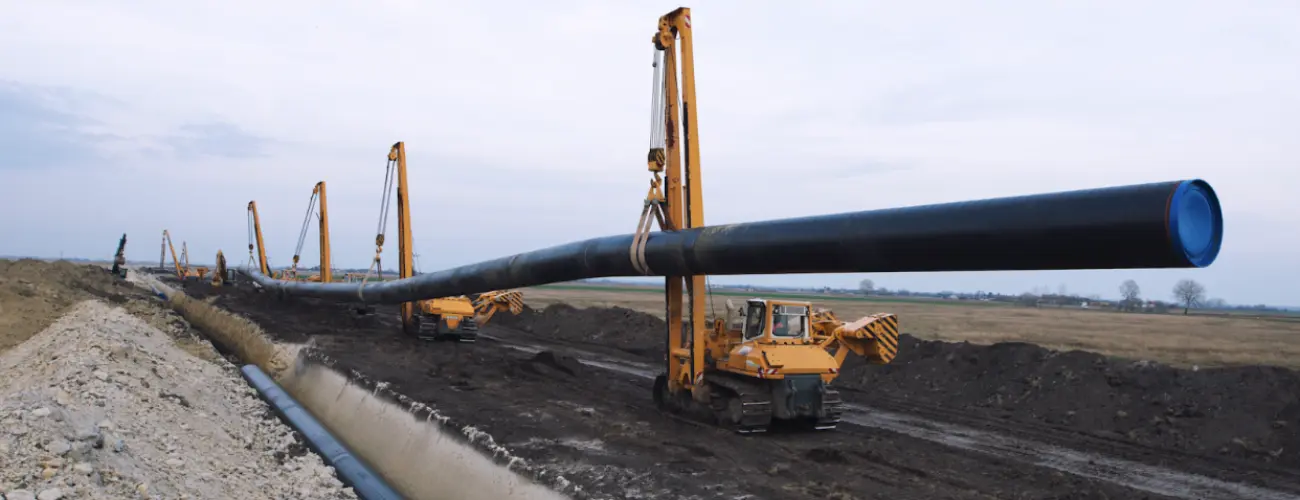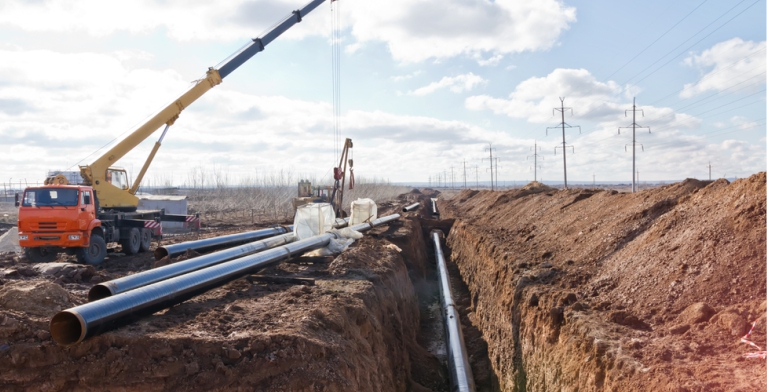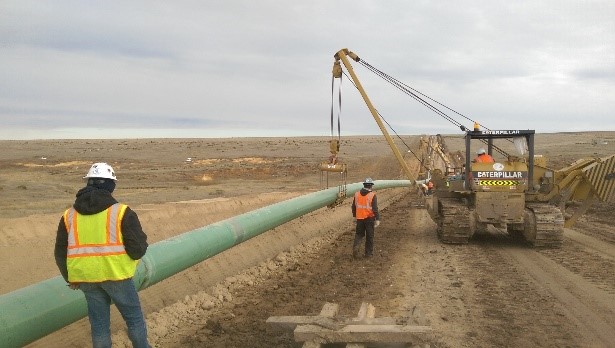Modern Project Management with Pipeline Construction Excellence
Changing Pipiline Construction: Ingenious Strategies for a Lasting Future
The landscape of pipiline construction is undergoing a substantial makeover, driven by the necessity for sustainability and performance. Emerging innovations, such as innovative materials and wise systems, existing possibilities to decrease ecological influence while improving functional dependability. The integration of environmentally friendly practices and area engagement is reshaping the typical strategies to framework development. The question remains: how can these technologies be properly implemented to assure not only the durability of pipes but additionally the health of the environments they traverse? Discovering this intersection might disclose important insights for the market's future
Advanced Products in Pipiline Construction
In recent times, various improvements in materials scientific research have actually considerably transformed pipiline construction, improving both longevity and effectiveness. The introduction of high-performance products has played a pivotal role in attending to the difficulties related to traditional pipiline systems, including deterioration, wear, and leak. The advancement of advanced composite materials, such as fiberglass strengthened plastic (FRP) and carbon fiber compounds, has actually led to pipes that are not just lighter however additionally show remarkable resistance to environmental anxieties and chemicals.Additionally, the application of polyethylene (PE) and polyvinyl chloride (PVC) has gained traction due to their excellent rust resistance and ease of installation. These products markedly minimize upkeep costs and expand the life span of pipes. Developments in covering technologies, such as fusion-bonded epoxy and advanced polymer finishes, provide additional security versus corrosion and mechanical damages, making sure the stability of pipelines in rough conditions.In addition, the combination of clever materials that respond to ecological adjustments is arising as a promising growth. These products can discover stress and stress, giving real-time information that can improve safety and security and functional efficiency. By making use of these innovative products, pipiline construction not just fulfills current industry requirements but additionally promotes sustainability via decreased resource usage and reduced ecological effect.

Smart Technology Assimilation
Smart innovation assimilation is revolutionizing pipiline construction by improving tracking, security, and functional performance. The fostering of Internet of Things (IoT) devices, man-made knowledge (AI), and progressed data analytics has actually changed traditional practices, giving real-time insights right into pipiline systems. These technologies permit constant tracking of pipiline conditions, allowing early discovery of potential problems such as leakages or structural weaknesses.For circumstances, wise sensors installed within pipiline facilities can communicate critical information regarding stress, temperature level, and circulation rates, promoting proactive maintenance and minimizing the danger of catastrophic failures. AI formulas analyze this information to forecast maintenance needs, optimizing functional schedules and reducing downtime. This predictive ability not only enhances the long life of pipiline systems but also substantially reduces operational costs.Moreover, the assimilation of drones and robot technologies right into pipiline construction and upkeep uses significant advantages. Drones equipped with high-resolution video cameras and thermal imaging abilities can carry out airborne assessments of pipes, identifying anomalies that may be invisible from the ground. Robotic systems can be released in unsafe atmospheres, making certain that human workers are maintained out of harm's method while still doing necessary tasks.Incorporating smart technology right into pipiline construction promotes a culture of security and efficiency, ultimately leading to decreased ecological influence and enhanced job timelines. As industry stakeholders remain to accept these innovations, the future of pipiline construction shows up increasingly interconnected, data-driven, and resistant.
Eco-Friendly Construction Practices
As the focus on environmental sustainability intensifies, the pipiline construction market is significantly adopting green practices. This includes making use of sustainable materials, methods to lessen ecological impact, and energy-efficient methods that boost total task practicality. By executing these practices, firms can not only minimize their eco-friendly impact yet also improve their operational performance.
Lasting Materials Usage
The combination of sustainable materials in pipiline construction is crucial for reducing ecological effect and advertising eco-friendly methods. Making use of products that are sustainable, recyclable, or have a reduced carbon footprint can considerably improve the sustainability of pipiline projects. Using high-density polyethylene (HDPE) instead of typical steel or PVC can lead to decreased power intake throughout production and installment, as well as enhanced long life and resistance to corrosion.Moreover, including recycled products, such as crushed concrete or recovered asphalt, can even more contribute to resource preservation and waste decrease. These materials not only decrease the need for virgin sources however likewise lower transport emissions related to material sourcing. In addition, bio-based composites and various other innovative products derived from renewable sources are acquiring grip, providing efficiency qualities comparable to standard choices while sustaining a round economy.Adopting lasting materials is not simply a trend; it represents an essential change toward accountable construction methods. As the industry relocates onward, the dedication to sustainable product use will certainly play a crucial role fit a greener future for pipiline construction, straightening with worldwide sustainability objectives and regulatory criteria.
Minimizing Environmental Impact
Integrating lasting materials is a fundamental action towards reducing the ecological impact of pipiline construction. The option of environment-friendly products, such as recycled steel and biodegradable finishes, greatly decreases resource removal and waste generation. Moreover, utilizing in your area sourced products can reduce transport discharges, contributing to a general reduction in the job's carbon footprint. Creek Pipe Industry Leadership.In addition to material selections, implementing finest practices in website administration is essential. Performing comprehensive ecological evaluations prior to construction helps recognize sensitive environments and permits the advancement of customized techniques to shield these locations. Strategies such as directional drilling can decrease land disruption, maintaining environments and maintaining soil integrity.Additionally, using sediment and erosion control actions throughout construction can protect against soil destruction and water contamination, further maintaining local ecosystems. Stakeholder interaction, including areas and environmental groups, cultivates transparency and cooperation, leading to ingenious solutions that attend to ecological concerns.Emphasizing continuous surveillance and adaptive monitoring throughout the construction procedure warranties that environmental influences are lessened and reduced successfully, enhancing a commitment to sustainability. By integrating these techniques, pipiline construction can advance right into a much more ecologically liable undertaking
Energy-Efficient Methods
While pipiline construction inherently entails considerable energy consumption, taking on energy-efficient strategies can substantially decrease the general power impact of the task. Implementing sophisticated technologies, such as automated equipment and drones, streamlines operations, lessens waste, and warranties accurate execution, therefore lowering energy usage during construction.Utilizing sustainable products, such as recycled steel and low-carbon concrete, additional improves energy efficiency - Pipeline Construction Excellence. These products not just decrease the power required for manufacturing yet additionally reduced the general ecological impact of the pipiline. Furthermore, enhancing transportation logistics by using local suppliers and reducing transport ranges can substantially reduce fuel consumption.Incorporating renewable resource resources right into construction processes is another critical strategy. Using solar-powered devices and generators can reduce dependence on fossil fuels, promoting a greener construction site.Moreover, labor force training and education on energy-efficient techniques can lead to even more conscientious decision-making on-site, fostering a culture of sustainability. By integrating these energy-efficient strategies, the pipiline construction industry can not just decrease its carbon emissions however likewise established a precedent for future projects, straightening with international initiatives towards an extra lasting infrastructure

Reducing Environmental Impact
Decreasing environmental effect during pipiline construction is vital for lasting development. This can be accomplished through the adoption of environmentally friendly products, the execution of innovative trenchless innovation, and the read more application of environment preservation approaches. By concentrating on these key areas, the market can considerably lower its ecological impact while keeping functional performance.
Eco-Friendly Products Fostering

Advanced Trenchless Innovation
Just how can progressed trenchless technology reinvent pipiline construction? This innovative strategy reduces environmental effect by substantially reducing surface area disturbance throughout installation. Typical pipiline construction approaches frequently require extensive excavation, causing habitat devastation, soil erosion, and boosted sedimentation in neighboring water bodies. In contrast, trenchless techniques, such as straight directional drilling (HDD) and pipeline bursting, permit for the setup of pipes with marginal ground disturbance.These techniques include creating a borehole underground, allowing the installment of new pipelines without the need for big trenches. Consequently, advanced trenchless innovation not only conserves existing landscapes but also lowers the carbon footprint connected with heavy machinery and transport. Additionally, these techniques can be carried out in metropolitan locations, where area is minimal and the possibility for ecological injury is heightened. Midland Pipeline Construction Authority.Furthermore, trenchless innovation is versatile to numerous soil conditions, making it a functional remedy for different geographical contexts. By integrating advanced trenchless approaches right into pipiline construction practices, the industry can pave the means for even more lasting development, making sure that facilities fulfills modern-day demands while protecting the integrity of the atmosphere
Environment Preservation Strategies
Sustainability in pipiline construction pivots on effective habitat conservation strategies that focus on ecological stability. These approaches are essential in lessening the ecological footprint related to pipiline tasks, making sure that local wildlife and ecological communities are secured throughout the construction process.One crucial technique includes performing thorough environmental influence analyses (EIAs) prior to job initiation. EIAs recognize sensitive habitats and types that may be influenced, allowing construction teams to develop tailored reduction strategies. Applying barrier zones around vital environments can greatly reduce disturbances, providing a haven for wildlife throughout construction.Another effective strategy is the usage of directional drilling and other trenchless innovations, which lessen surface area disruption by allowing pipes to be installed underneath delicate locations, such as marshes and rivers. This method not only secures delicate environments however also reduces the need for comprehensive land clearing.Additionally, utilizing native vegetation for repair post-construction is vital in advertising biodiversity. By reestablishing species that are native to the location, the ecological community can recuperate a lot more successfully, making certain that both the eco-friendly and aesthetic values of the landscape are preserved. Ultimately, these environment conservation strategies add to an extra sustainable and responsible strategy to pipiline construction.
Enhancing Precaution
While the demand for pipiline construction proceeds to rise, prioritizing precaution has actually never been more vital. As the sector develops, the execution of sophisticated safety procedures and innovations has ended up being important to reduce risks connected with pipiline installation and maintenance.One of the foremost strategies includes the fostering of rigorous training programs additional hints for workers. Verifying that workers are skilled in safety and security treatments, emergency reaction strategies, and the procedure of specialized equipment is important. Regular drills and simulations can boost their preparedness for unanticipated circumstances, thus lowering the likelihood of accidents.Additionally, the assimilation of sophisticated technology, such as drones and remote monitoring systems, plays a significant function in safety and security improvement. Drones can perform airborne assessments, identifying prospective hazards and permitting for real-time analyses without putting employees in danger. In a similar way, remote tracking systems can discover leaks or anomalies in pipiline systems, promoting timely interventions and reducing ecological impact.Moreover, the establishment of a durable security society within companies fosters liability and collective duty. Encouraging open communication concerning security issues and entailing all employee in the growth of safety protocols can bring about an extra attentive workforce.Lastly, conformity with market standards and laws is paramount. Routine audits and analyses confirm adherence to security standards, facilitating constant enhancement in safety efficiency. By embracing these actions, the pipiline construction industry can considerably boost safety, validating the security of workers, areas, and the atmosphere.
Cooperation With Regional Areas
Efficient pipiline construction not just rests on safety steps however also flourishes on cultivating positive relationships with neighborhood communities. Involving regional stakeholders is important for the successful implementation of pipiline tasks, as these communities commonly hold valuable understandings and worries concerning ecological, social, and economic effects. Building depend on with clear communication can reduce opposition and enhance job support.Collaboration with regional neighborhoods starts with early assessment. By including locals in the planning stages, pipiline companies can collect feedback and address particular concerns connected to land use, prospective environmental results, and area safety. This positive technique shows regard for local expertise and promotes a sense of possession amongst area members.Furthermore, pipiline projects can produce neighborhood work opportunities, thereby adding to financial advancement. Business must focus on hiring neighborhood labor and contracting local solutions whenever feasible. This not just supports the neighborhood however likewise enhances ties, as neighborhood employees often have a vested rate of interest in the job's success (Pipeline Construction Excellence).Environmental stewardship is one more essential aspect in partnership. Engaging with regional environmental groups can aid determine and apply lasting techniques that lessen eco-friendly interruption. This cooperation can cause cutting-edge options that straighten project goals with community worths
Future Fads in Pipiline Design

Frequently Asked Questions
Just How Do Pipiline Construction Techniques Affect Resident Wildlife Populations?
Pipiline construction methods considerably influence neighborhood wild animals populaces by changing habitats, interrupting movement patterns, and introducing toxins. Executing environmentally aware methods is important to minimize these effects and advertise coexistence in between infrastructure advancement and wildlife preservation.
What Are the Prices Related To Cutting-edge Pipiline Construction Approaches?
Ingenious pipiline construction techniques frequently entail greater ahead of time prices due to advanced modern technology and materials. Nonetheless, these financial investments can produce long-term financial savings via enhanced efficiency, minimized environmental effect, and lower upkeep expenses, ultimately profiting stakeholders.
Exactly How Is Public Point Of View Changing In The Direction Of Pipiline Construction Projects?
Popular opinion towards pipiline construction tasks is significantly crucial, driven by environmental worries and a need for openness. Neighborhoods now prioritize sustainability and safety and security, prompting stakeholders to adopt more liable practices and take part in purposeful dialogue with the public.
Are There Details Regulations Governing New Pipiline Technologies?
Yes, certain regulations govern new pipiline modern technologies, differing by region and country. These laws generally focus on security, ecological influence, and technical criteria to assure compliance with legal needs and public safety.
What Role Do Universities Play ahead of time Pipiline Construction Techniques?
Universities play a crucial duty beforehand pipiline construction techniques by performing study, establishing cutting-edge technologies, collaborating with industry companions, and offering education - Pipeline Construction Excellence. Their payments promote understanding transfer and promote lasting practices within the pipiline field